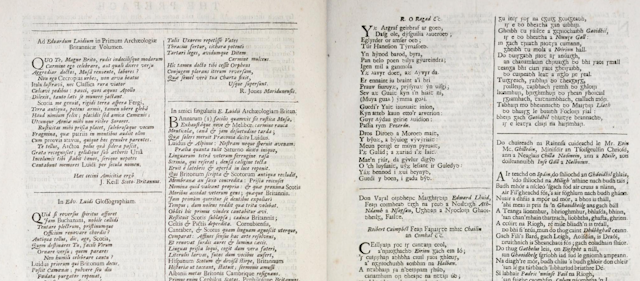The Scottish Gaelic language is experiencing a new surge of interest in Scotland and further afield. A Gaelic course launched on language learning app Duolingo in November 2019 has attracted 232,000 active learners in just four months, meaning there are just over four times more learners than there are Gaelic speakers in Scotland. Education in Gaelic is also experiencing high demand and expanding both within and beyond the language’s stronghold in the Western Isles.
Though once the primary spoken language in the majority of Scotland, Gaelic is a language that has been on retreat for several centuries. The current wave of initiatives to promote the language are to be welcomed, but this is not the first time that people have sought to make the language more accessible to others.
My research focuses on the way cultural and national identities developed in Scotland and Ireland during the 16th-18th centuries. I am particularly interested in the tensions between Gaels and Scots, and in Ireland where ethnic and religious divisions led to conflict. The politics of language played a key part in these processes and my work looks at how texts written in Gaelic, Latin, and English fed in to the development of identity.
Languages with a common thread
In the first decades of the 1700s, Edward Lhwyd, a brilliant Welsh linguist (who was also a botanist, geologist and antiquarian) came to understand the connections between the surviving Celtic languages: Gaelic (both Irish and Scottish), Welsh, Breton and Cornish. Through massive personal effort and the assistance of many helpful correspondents, he became proficient in all four languages and published a set of comparative dictionaries and grammars in his 1707 book Archæologia Britannica. This work explained the historical linkage of these languages and laid down the fundamentals necessary for his readers to learn them.
Once published, Lhwyd’s work was prefaced by pages of complimentary verse written by thankful and enthusiastic readers and correspondents. The poems in Welsh, Gaelic and Latin show us how Lhwyd’s readers responded to his work and how they valued his engagement with their native languages. A typical Gaelic verse reads:
Ceillfair soc is cantair ceol, / The ploughshare is put away and music is sung
A’nrioghachd Eirion gach ein ló; / in the kingdom of Ireland every day;
’s cuirfhar adhbha ciuil faoi ghleus, / and a musical instrument is tuned
a’ ngriochuibh aoibhin na Halban. / in the pleasant lands of Scotland.
Not all Lhwyd’s readers were so enthusiastic or courteous. Some indeed suspected that such interest in the languages of Ireland and Scotland could only signal some sort of political chicancery on Lhwyd’s part.
There is a contemporary equivalent to the positive response Lhwyd received that can be seen in the reaction to the launch of the Duolingo course. Many social media groups made up of learners and promoters of the language have sprung up. Most comments are simply thankful, like the verse to Lhwyd above. But the politics of Gaelic have not changed so much since 1707 when Scotland and England joined in a union of parliaments.
In January 2020, a political row erupted over new Gaelic education plans in the Western Isles after Tory MSP Liz Smith described the change as “a deeply troubling step and one that could put children … at a distinct disadvantage to their peers”, despite the well-researched advantages to bilingual education.
Lhwyd himself encountered just such arguments as those put forward by Smith though actually admitted that trade and commerce in Britain would be simpler if everyone just spoke English. But rather than reduce everyone to a functional monolingualism he saw his work as means for people of good will to come to understand one another’s tongues. This is a vision of linguistic understanding as an instrument of peace rather than economic gain. As one of his readers wrote:
Le caint a dhruidfair gach shith, / With speech every peace-accord is sealed
bheirthair adhradh don ard Riogh: / and worship given to the high King:
neach da fheabhas ’s fann a chor, / anyone of whatever worth, his plight is feeble
’s canamhuin a bhi da easbhuidh. / if he lacks language.
Three hundred years ago, Lhwyd and his readers were already beginning to comprehend that languages were not simply economic commodities, but could form the basis for a fuller flourishing of human understanding and connection.
Language, culture and politics
Reading comments in Gaelic learning forums on social media, a whole spectrum of attitudes and approaches that mirror those held by Lhwyd himself and those he encountered can be identified. Discussions about Scottish independence abound, users send each other lengthy messages on Gaelic, Scottish and Irish history and the nature of imperialism (generally these are both given and received good-naturedly).

I recently witnessed a cultural debate unfold on one of these forums on the controversial symbolism of the Red Hand of Ulster. Passions ran high, and, while I restrained myself from quoting medieval bardic poetry on the subject, the debate became an opportunity for genuine cultural interchange and learning.
While political debate is unavoidable on these forums, the general attitude appears to be one of goodwill, much like Lhwyd’s own attitude. Users are delighted to share language tips and cultural information. These forums are also used by native speakers who seem encouraged to practise their language skills and share their knowledge with those new to the language. Perhaps now we can really begin to say, as one of Lhwyd’s readers did three hundred years ago:
Do duisgadh riot as anúaigh, / The hardy tongue which was under a cloud
an chanamhuin chruaigh do bhi saoi small / has been roused by you from the grave,
teanga bhi cían faoi gheisaibh, / a tongue long under enchantment
do cuireadh leat a nglo re seal. / has presently been set in print.

